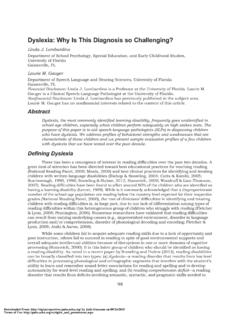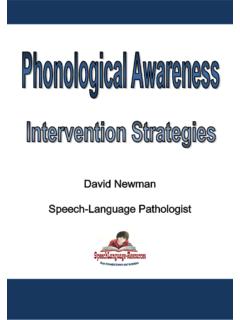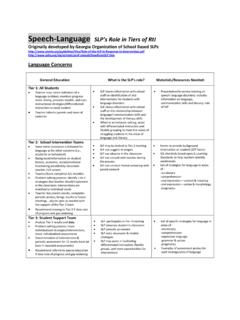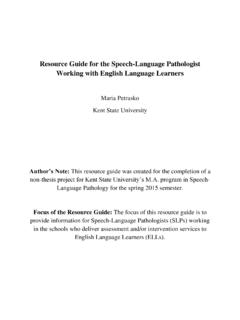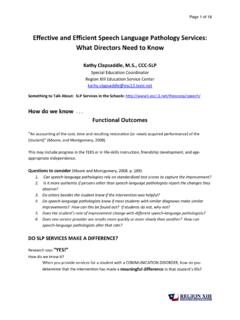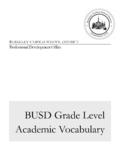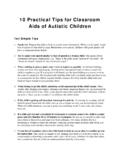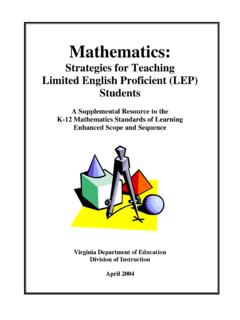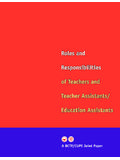Transcription of Alternative Methods of Assessment for English …
1 Alternative Methods of Assessment for English language Learners (ELL) Pamphlet Developed by: Florelia Baldiz n, Deanna Rutherford-Blowes, Monica O Neal, Alicia Powers, Lula Rashiti, Laura Rivera, Nilsa Torres Introduction: According to the American speech - language -Hearing Association (ASHA Perspectives, 2005), there are over 20 million children from Culturally and Linguistically Diverse (CLD) backgrounds in schools today and this number continues to grow. By 2030 ELLs will account for approximately 40% of the entire school-aged population in the (Roseberry-McKibbin and Brice, 2005). In Connecticut, 139 different dominant languages are spoken in the 164 public schools (CSDE, 2012). This brochure was developed to serve as a guide for speech and language Pathologists (SLPs) when assessing students who are considered ELLs. The material contained within this publication is just the tip of the iceberg of all the published information regarding this complex topic.
2 IDEA Law states ( Department of Education, ): States [must submit a plan that provides assurances of] policies and procedures designed to prevent the inappropriate over-identification or disproportionate representation by race and ethnicity of children as children with disabilities. 20 1412(a)(24) CT Guidelines Modifications and adaptations of standardized test procedures invalidate the use of test norms, but may provide qualitative information about a child s language abilities. If a test administration appears to be invalid for any reason, test scores should not be subjected to usual interpretations and the reasons for invalidation should be clearly stated in oral and written presentations of test results. (Connecticut State Department of Education, 2008). In determining if an ELL student qualifies for speech and language services it is essential to differentiate between a language disorder and language difference (Roseberry-McKibbin, 2002).
3 DEFINITIONS English language Learner Individuals in the process of acquiring English as a second language while learning academic content (Roseberry-McKibbin, 2002). There s a variation in language proficiencies where no two bilingual students present the same characteristics in their language , experiences, and culture. speech / language Difference Present if difficulty in communication (oral/written) and/or speech production is impacted by the process of learning a second language . (Roseberry-McKibbin, 2002). speech / language Disorder Present if difficulty comprehending and using language (oral/written forms) and/or producing speech (sounds, fluency) in language 1 (for monolingual students) and in language 1 and language 2 (in bilingual students) or when difficulty is not a product of a language difference (Roseberry-Mckibbin, 2002).
4 ROLES OF THE SLP Bilingual Provider (ASHA Code of Ethics, 2010) Bilingual service providers must be able to speak their primary language and speak (or sign) another language with native or near-native proficiency in lexicon, semantics, phonology, morphology/syntax, and pragmatics during clinical management. The bilingual audiologist or speech - language pathologist should possess the ability to: Describe the process of normal speech and language acquisition for both bilingual and monolingual individuals and how those processes are manifested in oral (or manually coded) and written language ; Administer and interpret formal and informal Assessment procedures to distinguish between communication differences and communication disorders in oral (or manually coded) and written language ; Apply intervention strategies for the treatment of communicative disorders in the client s language ; and Recognize cultural factors that affect the delivery of speech - language pathology and audiology services in the client s language community.
5 Monolingual Provider s Role Monolingual speech and language pathologists should be aware of IDEA and ASHA s code of ethics. Discrimination based on race, ethnicity and nationality is illegal and unethical when testing and providing services. The SLP needs to know cultural differences and expectations. They need to determine the language history, the need for interpreter/translator or a bilingual SLP, and the availability of Assessment tools in the native language (Banotai, 2004). EVALUATION VS Assessment (Ortiz, 2008) IDEA 2004 (USDE, ) states that test scores are not required to determine eligibility for services under the federal law. This is emphasized by having all references to tests changed to Assessment materials . Evaluation Assessment Eligibility-driven Instructionally-driven Classification-driven Focus on intervention planning Traditional tools preferred Authentic tools valued most Standardized measures valued most Ethnographic Approach Skills-driven Collaborative Approach Skills & Process-driven Assessment Methods * Research suggests that traditional approaches to the Assessment of ELL students' communication skills are often biased in regard to both language and culture.
6 Best practice in the Assessment of ELL students includes the use of Alternative Assessment Methods in addition to use of multiple measures, some of which are outlined below (Rhodes, Ochoa, & Ortiz, 2005). Assessment Methods Explanation language Use and Proficiency What it is: A measure of a student s level of language proficiency and frequency of use of a specific language Guiding Principles: Prior to the development of any Assessment , comprehensive information should be collected regarding the student's level of language proficiency in BOTH his/ her native language (to the extent possible) as well as in English . Moreover, information regarding a student's cognitive academic language proficiency (CALP), critical for school success, as well as his/ her basic interpersonal communication skills (BICS) should be collected and documented (Rhodes, Ochoa, & Ortiz, 2005).
7 Examples: Bilingual language Proficiency Questionnaire- English and Spanish (Mattes & Santiago, 1985) available from Academic Communication Associates; language Assessment Scales (LAS)- Oral; LAS LINKS (McGraw Hill, 2013); Student Oral language Observation Matrix (SOLOM) ; observation. Ethnographic Interviewing What it is: A method of obtaining a vivid description of student s life experiences by interviewing caregivers. Using ethnographic interviews, an SLP can develop an understanding of the student's and family's perceptions, views, desires, and expectations (ASHA, 2013). Guiding Principles: Families are invaluable resources in helping SLPs differentiate between language and learning differences and disorders. Families provide information about a child's developmental and school history, language use and proficiency, level of acculturation, and family history (Collier, 2011).
8 Examples: Bilingual Health and Developmental History Questionnaire (Gomez-Valdez, 1998) available from Academic Communication Associates. Teacher Questionnaire/ Interview What it is: A method of obtaining qualitative information about a teacher's perceptions of a student's language learning and communication skills within the classroom and school setting. (Roseberry-McKibbin, 2002). Guiding Principles: Teachers, much like families, are also critical sources of information that can assist SLPs differentiate between language and learning differences and disorders. Practitioners should be aware of the teacher's level of experience when working with students from diverse backgrounds and how such factors may influence a teacher's perceptions (Rhodes, Ochoa, & Ortiz, 2005. Examples: Bilingual Classroom Communication Profile (Roseberry-McKibbin, 1993) and the Classroom language and Learning Checklist (Academic Communication Associates, ), both available from Academic Communication Associates.)
9 Acculturation Questionnaires/ Interviews What it is: Acculturation is a process in which members of one cultural group adopt the beliefs and behaviors of another group (Collier, 2011). Guiding Principles: The more a child s culture differs from the dominant culture in which they live, the greater the chances that learning will be adversely affected. Factors critical to the success in the acculturation process involve the presence of bilingual/ ESL programs in a school or district, the strength of a student or family's English language and/ or native language skills, the length of time in school and the amount of interaction with mainstream, American students (Ortiz, 2004). Examples: The Acculturation Quick Screen by Catherine Collier (Collier, 1999); observation; interview. Norm-Referenced, Standardized Tests What it is: A standardized test is a test that is administered and scored in a consistent, or "standard" manner.
10 A norm-referenced test is a type of test, Assessment , or evaluation that yields an estimate of the position of the tested individual in a predefined population, with respect to the skill being measured (Wikipedia, 2013). Guiding Principles: To date, the ELL students are not adequately represented within the normative samples associated with most commercially-available, standardized tests, thereby limiting the validity of any test results. Simply because a test is available in a student's native language does not necessarily mean that the test is culturally and linguistically appropriate for the student in question (Rhodes, Ochoa, & Ortiz, 2005). SLPs must remain vigilant throughout the Assessment process about any possible sources of bias that could negatively influence a student's performance on standardized measures. Nonetheless, the use of standardized tests (without the use of scores) may provide valuable qualitative information regarding a student's skills.
